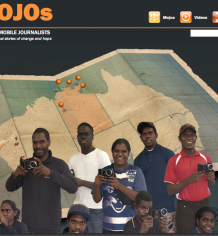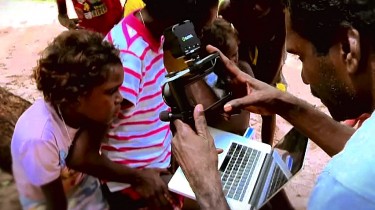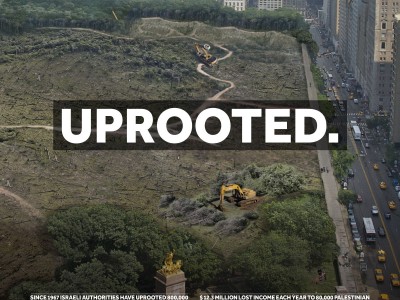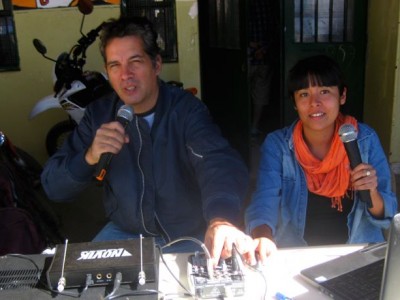Rising Voices note: This post written by Melissa Ulbricht was originally published at the Mobile Media Toolkit site and it is republished with permission.
NT Mojos, a project Australia's Northern Territory, empowers indigenous people to have a local voice and to provide a less marginalized view of everyday life by enabling them to create and share mobile stories.
In a crisp, 6-minute mobile video, Gerald Yawulkpuy introduces the local news from his community.
Welcome to Ramo News – all the news from Ramingining. My name is Gerald Yawulkpuy, good evening.
Tonight, the very successful Youth Week Program. The Court in town for the first time, and the opening of our wet season swimming pool.
But first of all, an update on the critical situation in Ramingining about the road conditions and the fuel for the power station.
 Gerald is just one of a growing number of mobile journalists, or Mojos, creating video stories from remote regions in the Northern Territory of Australia. He learned how to use an iPhone kit to create, edit, and upload news stories as part of a project called NT Mojos, which is funded by the Australian government in partnership with Burum Media and the Batchelor Institute of Indigenous Tertiary Education.
Gerald is just one of a growing number of mobile journalists, or Mojos, creating video stories from remote regions in the Northern Territory of Australia. He learned how to use an iPhone kit to create, edit, and upload news stories as part of a project called NT Mojos, which is funded by the Australian government in partnership with Burum Media and the Batchelor Institute of Indigenous Tertiary Education.
The project empowers indigenous people to have a local voice and to provide a less marginalized view of everyday indigenous life in Australia by enabling trained reporters in remote communities to create and share the stories most important to them. The final videos are posted on a government site as well as here.
A Passionate Leader Brings Energy to the Project
When it comes to NT Mojos, the executive producer Ivo Burum wears many hats. It was his idea to launch the pilot after over 30 years of experience in the field as a reporter and broadcaster. Most recently, with the Australian Broadcasting Corporation (ABC), Burum taught people to use small cameras to create and deliver content for television, including shows like Race Around Oz.
“While mobile is quite new, the concept of people creating self-shot content is not,” he said. With NT Mojos, Burum is revisiting lessons from earlier experiences with user-generated content, but instead of focusing on large infrastructures such as television programs, is spending money on training in indigenous communities.
As part of his daily work, Burum travels to remote communities in the Northern Territory to help select participants and lead the trainings. For more on the project, watch this documentary on The Making of NT Mojo:
Says Burum, “I take Mojo quite seriously. It’s a real opportunity for people to change their lives and to create a citizen voice — and that’s what is important.”
It’s More about the Story and Less about the Technology
In selecting Mojo participants for training, the first step is to engage the community and talk to local elders to see if they want to be involved. If they do, Burum meets with them to help select candidates. In one eager community, 15 people lined up to join the training. “It’s not difficult to sell the idea to communities,” Burum said. He also brings in existing media centers and indigenous engagement officers to help choose participants.
For the pilot, 9 Mojos were chosen from 6 communities in the Northern Territory: Galiwin’ku, Lajamanu, Numbulwar, Ramingining, and Wurrumiyanga (Nguiu).
Training is initially held at the Batchelor Institute, where Burum and others teach aspects of storytelling as well as technical skills on iPhone mobile journalism kits. After the training intensive is complete, the Mojos return to their communities, ready to hit the ground running. “One of the goals is to get Mojos to a point where they can make stories without continued support from myself or the Institute”, Burum said.
The bulk of the training focuses on fundamentals of journalism and teaching the who, what, where, when, and why of story construction, as well as being an ethical storyteller or journalist. The tech stuff comes more naturally. Burum said that when the Mojos first got their hands on the iPhone kits, they immediately began recording, before they were even taught how. “It seemed intuitive”, he said.
Each Mojo receives a “kit”, based around the iPhone 4. Other hardware components include:
- An OWLE Bubo mount for the camera. This helps stabilize the phone and allows for other external attachments.
- A multi-directional mini shotgun microphone, which is attached to the OWLE case.
- A small rechargable LED light. This helps for recording at night or in low conditions.
The kit that includes an iPhone costs less than $900 AUD.
 NT Mojos use Vericorder’s 1st Video editing app, chosen because it allows editing on up to four tracks of audio and two tracks of video and has super and subtitle features, essential for indigenous language work. It also has a resume function that enables the app to re-start uploads from a drop out point, in case of a temporary loss of signal. In the remote regions of the Northern Territory, most of the uploading is done via a 3G network instead of over WiFi.
NT Mojos use Vericorder’s 1st Video editing app, chosen because it allows editing on up to four tracks of audio and two tracks of video and has super and subtitle features, essential for indigenous language work. It also has a resume function that enables the app to re-start uploads from a drop out point, in case of a temporary loss of signal. In the remote regions of the Northern Territory, most of the uploading is done via a 3G network instead of over WiFi.
Stories are shot and edited directly on the phone, and uploaded to the Internet when complete.
Education and Income
It was not too difficult to get funding for the project. For one, Burum Media has a good track record with media production in Australia. Second, timing was right. The government is looking for ways to engage with remote communities and help “close the gap,” Burum said. “NT Mojos is a way to bridge a divide between white and indigenous Australia.”
Another ongoing issue in this region is education and literacy. Because NT Mojos teaches story-telling first and technology second, the project is “as much about increasing literacy levels and helping people think about their environment and how to convey those thoughts and stories,” Burum said.
After returning to their communities, the trained Mojos are able to report on any story they choose. It is important to teach journalism concepts of defamation, libel, and story accuracy, as the NT Mojo’s were not clear about this. “When you are speaking about issues you are passionate about, you want to be sure you can broadcast and share the stories with a larger audience without fear of libel actions,” Burum said.
These larger lessons contribute to the sustainability of the project, as does continued involvement within the community, from elders, teachers, and media centers. Burum’s goal, he jokes, is to not have to go back to regions where he has taught.
A key to sustainability is to link income to skills learned. Following the Mojo's success at the Fist Full of Films festival in Darwin, ABC asked if nine of the original trainees could contribute to the public broadcaster as paid freelance stringers based in the remote communities. “That’s a wonderful thing because education is one thing, but creating jobs after you are educated in a remote community is another thing,” Burum said.
Burum believes another important step on the road to sustainability is to integrate Mojo into the education system in remote schools in the NT. “It’s critical to get these natural storytellers thinking about story telling the modern way as early as possible and that’s the way mojo is heading in the NT — into schools as part of the curriculum,” he said.
Burum has also launched a version of the project in China, called Ningbo Mojo. The pilot began with 10 mojos and 4 teachers from Nottingham University in Ningbo, China in June 2011. The same iPhone kits and Vericorder apps are used, though Burum finds that upload issues arise more often due to Internet censorship in the country. “Despite the restrictions, the Ningbo mojos from the Nottingham University Television Station used mojo for their broadcast work including filming a media conference in Ningbo.” Another introductory and intermediate workshop is planned in Ningbo this year.
The Burum Media mojo package has also been delivered to a secondary school in Melbourne and to ‘J’ students at Deakin University. Burum has tips on mobile journalism at the How To Mojo blog and more NT student videos on his YouTube channel. More info on the My School Mojo package can be found at www.burummedia.com.au.
For more guides on mobile audio and video reporting, see this list of iPhone tips from the International Journalist’s Network, this how-to guide on Mobile Audio Recording from the Field, and the Mobile Media Toolkit sections on Creating andSharing Mobile Content.
Photo courtesy of Ivo Burum.




9 comments
This is very great. I work in some remote faming communities in Ghana and I have realized the need to link such farming commuities with market locations where they can sell their produce at good prices. How do we make use of your training kit. provide your website